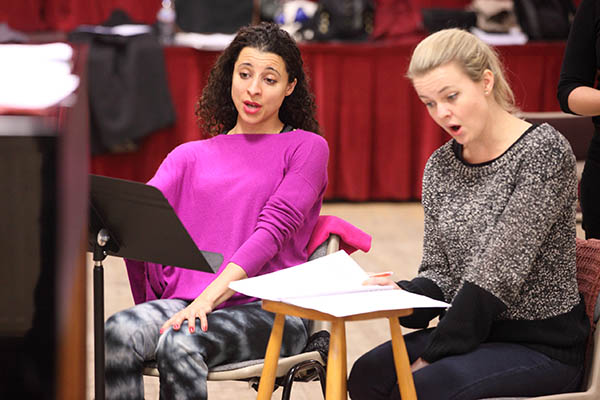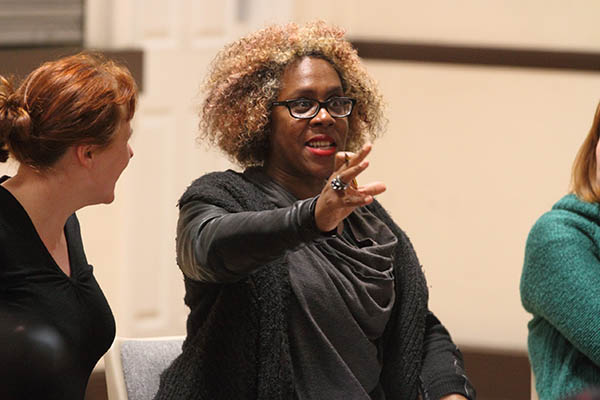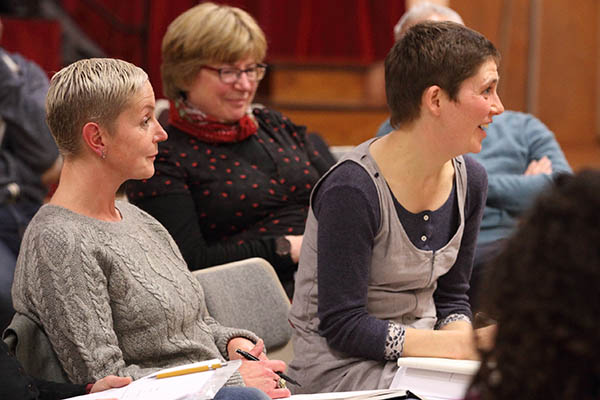An opera by Errollyn Wallen
premièring at Llanover Hall Arts Centre, Canton, Cardiff on Friday 14 March 2014

Photo Credit – Brian Tarr
(1) The Development of a Contemporary Opera
When I talked to the composer Errollyn Wallen for an article I was writing on youth opera I was fascinated to hear about Anon, the opera which Welsh National Opera had commissioned from her as part of their current season, Fallen Women, and I decided to follow its development. Errollyn’s first commission from WNO was Carbon 12 in 2008, a choral symphony which I saw from the inside as a member of the community chorus. Her writing for voices in that work was emotionally powerful, and I do not think either those who sang in it or those who came to listen will ever forget, in particular, the power of the driving rhythms of her depiction of the Aberfan disaster.
Inspired by the story of Manon Lescaut but turning it on its head to bring it into the modern world, Anon is about the exploitation of young women around the world. Its target audience is young people of 16 and upwards, presenting them with issues which are real in their lives and giving them food for thought. In this piece Errollyn has put her emotional investment into the libretto as well as the music, inspired by workshops and interviews with young women in Birmingham, in which they talked frankly about their lives and the pressures they face. The development process was facilitated by WNO’s Youth and Community Department in association with Sampad South Asian Arts in Birmingham. By the time I talked to Errollyn last autumn, she had already drafted both words and music, and I came into the process for the third workshop with the cast of five – three soprano singers and two actors. Here are some notes from my diary, and my thoughts looking back.
Dec 4th 2013, Welsh Centre, London
The Welsh Centre is a long walk down Gray’s Inn Road from King’s Cross Station. I arrive there to find cast and creative team members assembled in an echoing rehearsal room. The singers are clustered around a piano with musical director Stuart Wild, and are singing their way through the score of Anon. One of the singers will not be in the production as she is heavily pregnant – the symbolism of this only strikes me later! The actors who are there aren’t those who will be in the eventual show either. They’re there to help the composer and the director Wils Wilson as they work on the shape of the piece. It’s a chamber opera, about 45 minutes long, with 19 micro scenes. Lots to convey in a short space of time. Compressed, terse; to a full-length opera what a short story is to a novel.
At the end of the afternoon everyone, including visitors like me, is invited into a circle, and people talk about what has struck them most about the piece, about the work on it during the workshop. Certain sections are highlighted. There’s one called ‘The Mothers’ that’s particularly struck people in this emotional roller-coaster of a piece. People talk about the importance of hearing the words and the MD points out the difference between loud music, which people can hear, and soft music which people listen to, as it draws them in. I give a little cheer inside, remembering contemporary pieces in which the singers screamed at the tops of their ranges and I understood nothing. I go out into the evening and return to Wales with the sounds of the stories pulsing in my brain.
Errollyn now has to go off and finalise the score, in between all her other projects. The designer has to work out a set that will serve the piece and be suitable for touring. Auditions have to be held for the remaining cast members. The next time everyone meets it will be under three weeks before the opening night.
Feb 28th 2014, Rehearsal Room 2, Wales Millennium Centre, Cardiff
It’s day 4 of rehearsals. The final cast is assembled. I meet them at the rehearsal room door, five young women. They are all confident, professional, relaxed. They met as a group for the first time only a few days ago but have clearly already bonded. In Anon they will act and speak for those who are often obliged to remain silent. This piece is for them. It is young women speaking to young women. The work I observe is inspiring. In these days of financial cutbacks I am impressed that WNO has been prepared to invest in new work like this, though the composer is also investing heavily in the process herself, choosing to be present throughout nearly all of an intensive two-and-a-half-week rehearsal process. Having Errollyn there is so clearly inspiring for the cast. And she is down-to-earth with it, telling me to come and be amongst them, not on the sidelines, offering me a doughnut, open and easy to talk to.

Photo Credit Brian Tarr
The cast and creative team are going through a sequence near the end of the opera. Stuart, the MD, works with the singers on details of inflection, tells one of them to put a false word stress on the ‘dis’ of the word ‘dishonour’ to make sure it comes across clearly. They talk about whether to use vibrato or not in their singing to make it clear when they are playing young women. I talk with Errollyn about the issue of audibility of words. She says that there are places where she’s written the music lower to ensure the words come through – ‘People really need the words’ – but that in other places it’s the music that carries the emotion. There’s a particular section: Stuart remarks that one of the reasons this is working so well is that the speed of the three singers’ vibrato is virtually the same. It’s true, a stunning moment. Errollyn has just been to New York and had the opportunity to workshop the piece with singers over there. She tells me it gave her a fresh perspective on the piece, though she clearly wouldn’t swap those singers for the three assembled in Cardiff.
Wils, the director, is working with the actors and singers on what she called a vocabulary of movement. It’s her first opera but she’s steeped in innovative theatremaking and will clearly bring so much from that to make this piece live. She talks about the performers portraying the history of women as a whole when they’re moving as group – and experiments with ways in which one or another can move so that the focus is on her as an individual. I see the piece growing organically as they repeat a scene. Remember the French word for rehearsal – ‘répétition’. Doing it again and again, developing it like a photograph – and then once more, to fix it.
I talk to Amanda Stoodley, the designer. Errollyn had told her about an exhibition she’d seen in Venice by the Chinese artist Ai WeiWei. He had made a piece in which people looked through peep-holes. Errollyn wanted a set which could create a feeling for the audience of things happening behind closed doors. Doing the same for Anon needs a creative approach, because this production is touring to six venues. Amanda’s made a floor, a mat with different patterns that conveys a domestic environment, from different cultures. The ‘walls’ of the set are made up of a jumble of furniture. Only it’s not a jumble, it’s a cityscape, a place as Amanda says, ‘of freedom, anonymity and safety, but one which can turn against you and become a threat.’ And alongside will be the band, an ‘instrumentscape’ which is part of the whole.
Later on Amanda is calling the performers one by one to try on costumes. Errollyn doesn’t want to see those yet … Meanwhile the singers are recording a particular section which is going to be mixed into a soundscape for a scene in a night club … The afternoon passes in a whirl of creative activity.
March 6th, Orchestral Hall, WMC, Cardiff
The Anon rehearsal has already started when I arrive. I sit down in a space where I can see and hear but don’t think I’m in the way, only to find that two of the singers start singing alongside me. It’s okay, I’m told, the two singers start that scene in the audience. This is most definitely not a conventional proscenium arch style production. Audiences will not be able to let their ears lie back in an easy chair (I’m quoting Charles Ives); they will be involved!
Percussionist James Gambold and cellist Joseph Spooner are in the room alongside Stuart on keyboards – this is the first time the full cast is assembled and working together. Amanda’s mat is down, the performers are working with scarves, an adaptable part of their costume. The performers are – literally – anonymous, but through the piece they play women of different ages. They also play men. Use of the scarves will help to signpost this. The development of the staging is going well, but they’ve been hit by illness. One of the singers has had to miss several rehearsals because of tonsillitis, but everyone’s staying positive, saying it will all be okay. They do have a cover, someone who’s learnt all three girls’ parts, but obviously using her will be a last resort. Meanwhile one of the production staff is standing in, learning the moves to pass on. There’s no apparent drop in energy in the room. Errollyn is constantly encouraging to everyone, collectively and individually. This process engenders great trust. Errollyn tells me that when she has to leave before the final days’ rehearsals she knows the work will be in safe hands.
I sit alongside Errollyn as the performers work on a scene in which there is a lyrical cello line. ‘Ah,’ she says, ‘I’ve just realised, hearing this, that the cello is the breathing, the breathing of the protagonists, the passionate heart.’ Then we’re on to a percussive section in which the cellist is plucking, now acting as the bass. Errollyn seems to me to work very intuitively, perhaps that’s why her music sounds so natural.
Of course there are hiccoughs, many of which I doubtless don’t witness. Some I do – Stuart is frustrated at not having a real piano, at having to use just keyboards. Not just because of technical hitches in changing from one sort of sound to another – which the stage management people address patiently – but because he cannot get the bloom on the sound which a piano would impart. Cost prohibits touring a real piano, or getting one in at all the venues. Much depends on the willingness of the whole creative team to compromise.
In spite of the pressures no-one throws a hissy fit. Wils works with the singers on how they can convey restlessness through their movement on stage as well as in their voices. She tries things different ways, saying ‘There are always a zillion, zillion options.’ I am struck by the mutual respect, by everyone’s attention to excellence. Errollyn is concerned that the players should be aware of the extraneous sound of page turns; Brenda Knight, the person who is responsible for calling the show, making sure that everything runs smoothly in performance, says when words aren’t audible and is thanked for doing so; Amanda is stitching a headscarf for one of the actors. And so on. It is a model of co-operative work.
When I leave at 5pm cast and crew are taking a break, but returning to work until 9pm. Making an opera is exhilarating but, boy, is it hard work!
March 10th, Llanover Hall Arts Centre, Canton, Cardiff
We’re in the hall where the first performance of Anon will take place in just a few days’ time. This afternoon is the sitzprobe, the first complete run-through of the music by the singers and full band. No movement or costumes.

Photo Credit Brian Tarr
Two weeks of long days rehearsing means everyone is tired by now. Errollyn has been up since 6am and when I meet her before going into the hall she’s feeling nervous because the singer who was sick is still not back to full strength. She says, ‘I haven’t heard the whole piece yet, but it does sound the way I want it to sound and I’m very happy with the cast we’ve got. It was a bit of an experiment to have actors integrate with singers and it’s working really well.’
Helen Gorton, the Stage Manager, introduces the cast to the space they’re going to be working in this week and points out that, with floor lights now in place, ‘There’s lots more stuff to trip you up.’ We’re in an Arts Centre, not a purpose-built theatre. Acknowledging that the facilities are basic, Wils focuses on the positives: ‘The whole point of this tour is taking the work to places where opera doesn’t normally happen,’ and ‘all the experience and super-professionalism’ in the team.
During the run-through Errollyn visibly relaxes, giving praise to the singers: ‘You’re singing as a unit – yes!’ Steve Lewinson, who’s made the digital soundscape, is here and helping out with sound balance. Steve’s an actor and composer but perhaps most importantly for the work on Anon, he and Errollyn are old friends. ‘It’s good to work with friends,’ she says to me. Knowing you have shared values is bound to be a good starting point for work like this which is tremendously exciting but also very demanding.
There’s lots of tweaking of speeds and dynamics during the run-through; Stuart and Errollyn are in constant dialogue. Errollyn has to be away for part of the time during the final run-up to the first performance because she has a work being performed by the BBC Symphony Orchestra on Thursday and has to go and rehearse it with them. She’s feeling frustrated about that, wishing the two things weren’t happening during the same week. She smiles, shrugs her shoulders. That’s the musical world.
After tea Wils is working on the staging when there’s an accident; one of the singers gets her leg tangled in a chair and injures her shin. Helen is straight there with an ice-pack – something in every stage manager’s kit it seems! Once more I’m impressed at the way such incidents are dealt with, with care and calm. It’s not too serious an injury, fortunately. The work continues, and it’s going to be another long day.
The last words in this preview of Anon should go to the singers and actors. They are the ones giving voice to those women who are kept silent, the ones Errollyn Wallen is acknowledging in this opera. I asked them what had been special about working on the development of Anon and these are some of the things they told me:
‘Errollyn and Wils have created something meaningful and beautifully haunting – it’s a treat that we as actors get to be a part of that. Usually as actors we don’t get to work with such rich and intricate music alongside world-class musicians.’ Shin-Fei Chen, Actor.
‘For me it has been to work as one of 3 sopranos as it never happens in opera and as women we are actually given a voice.’ Claire Wild, Singer.
‘As an actor I’ve had to apply different techniques and skills because I switch between characters, male and female. Sometimes it can be difficult, but I love a good challenge. I’m having so much fun, and I can’t wait to get it up and about.’ Ronke Adekoluejo, Actor.
The tour schedule for Anon is at http://www.wno.org.uk/anon


 Enjoyed this article? Support our writers directly by buying them a coffee and clicking this link.
Enjoyed this article? Support our writers directly by buying them a coffee and clicking this link.







